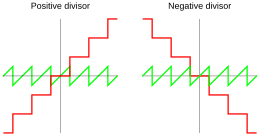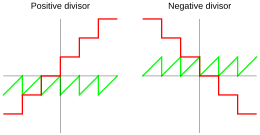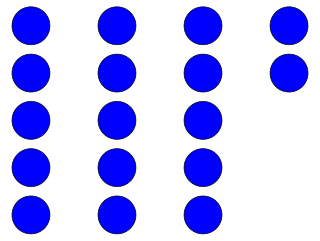Variants of the definition
In mathematics, the result of the modulo operation is an equivalence class, and any member of the class may be chosen as representative; however, the usual representative is the least positive residue, the smallest non-negative integer that belongs to that class (i.e., the remainder of the Euclidean division). [2] However, other conventions are possible. Computers and calculators have various ways of storing and representing numbers; thus their definition of the modulo operation depends on the programming language or the underlying hardware.
In nearly all computing systems, the quotient q and the remainder r of a divided by n satisfy the following conditions:
- (1)
This still leaves a sign ambiguity if the remainder is non-zero: two possible choices for the remainder occur, one negative and the other positive; that choice determines which of the two consecutive quotients must be used to satisfy equation (1). In number theory, the positive remainder is always chosen, but in computing, programming languages choose depending on the language and the signs of a or n. [lower-alpha 1] Standard Pascal and ALGOL 68, for example, give a positive remainder (or 0) even for negative divisors, and some programming languages, such as C90, leave it to the implementation when either of n or a is negative (see the table under § In programming languages for details). a modulo 0 is undefined in most systems, although some do define it as a.

Quotient (q) and remainder (r) as functions of dividend (a), using truncated division Many implementations use truncated division, for which the quotient is defined by
where is the integral part function (rounding toward zero), i.e. the truncation to zero significant digits. Thus according to equation ( 1 ), the remainder has the same sign as the dividenda so can take 2|n| − 1 values:

Quotient and remainder using floored division Donald Knuth [3] promotes floored division, for which the quotient is defined by
where ⌊⌋ is the floor function (rounding down). Thus according to equation ( 1 ), the remainder has the same sign as the divisorn:

Quotient and remainder using Euclidean division Raymond T. Boute [4] promotes Euclidean division , for which the quotient is defined by
where sgn is the sign function, ⌊⌋ is the floor function (rounding down), and ⌈⌉ is the ceiling function (rounding up). Thus according to equation ( 1 ), the remainder is non negative:

Quotient and remainder using rounded division Common Lisp and IEEE 754 use rounded division, for which the quotient is defined by
where round is the round function (rounding half to even). Thus according to equation ( 1 ), the remainder falls between and , and its sign depends on which side of zero it falls to be within these boundaries:

Quotient and remainder using ceiling division Common Lisp also uses ceiling division, for which the quotient is defined by
where ⌈⌉ is the ceiling function (rounding up). Thus according to equation ( 1 ), the remainder has the opposite sign of that of the divisor:
If both the dividend and divisor are positive, then the truncated, floored, and Euclidean definitions agree. If the dividend is positive and the divisor is negative, then the truncated and Euclidean definitions agree. If the dividend is negative and the divisor is positive, then the floored and Euclidean definitions agree. If both the dividend and divisor are negative, then the truncated and floored definitions agree.
As described by Leijen,
Boute argues that Euclidean division is superior to the other ones in terms of regularity and useful mathematical properties, although floored division, promoted by Knuth, is also a good definition. Despite its widespread use, truncated division is shown to be inferior to the other definitions.
— Daan Leijen, Division and Modulus for Computer Scientists [5]
However, truncated division satisfies the identity . [6]



































